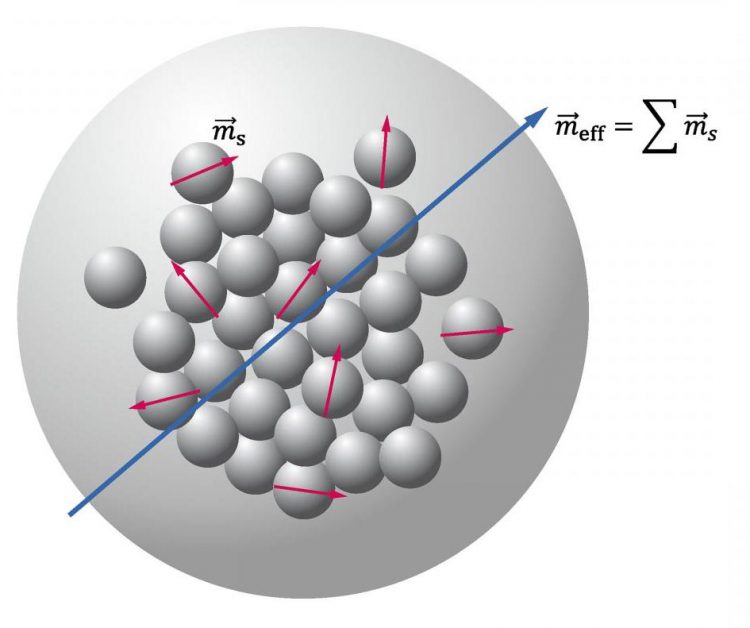Determining effective magnetic moment of multicore nanoparticles

Schema of multicore magnetic nanoparticle comprising N randomly oriented magnetic crystallites (gray spheres) each having a magnetic moment m_s. For clarity, the magnetic moments of only a few crystallites are shown. The effective magnetic moment of the multicore nanoparticle is given by the vectorial sum of the nanocrystallite magnetic moments. Credit: Frank Ludwig
Magnetic nanoparticles, a class of nanoparticles that can be manipulated by magnetic fields, have a wide range of technical and biomedical applications, including magnetic hyperthermia, targeted drug delivery, new magnetic storage media and nanorobots.
Most commercial nanoparticles do not possess a single magnetic core but have a number of small magnetic crystals called crystallites.
The important question for researchers is how these crystallites behave inside a multicore nanoparticle and how they respond to an applied magnetic field. A paper in the Journal of Applied Physics, from AIP Publishing, compares the effective magnetic moments of different multicore nanoparticle systems and shows that they are magnetic-field dependent.
“The effective magnetic moment of such a multicore nanoparticle depends on various parameters, such as the size of magnetic crystallites, their packing density, core configuration and the magnetic interaction between them,” said Frank Ludwig, one of the authors of the paper.
Many experimental findings indicate that the ensemble of crystallites behaves like a single magnetic core with some effective magnetic moment. Research has been directed toward determining how this effective magnetic moment is related to the number and size of crystallites inside one multicore nanoparticle because many applications require a large magnetic moment, which, e.g., determines the strength of the magnetic force needed for their manipulation.
The paper's findings are important for researchers optimizing magnetic nanoparticles for various applications, including magnetic hyperthermia and magnetic drug targeting, two new frontiers in cancer therapy.
In magnetic hyperthermia, the nanoparticles are located at the tumor cells. A magnetic field with a frequency and amplitude that will heat the nanoparticles to a temperature of approximately 42-44 degrees Celsius is applied, which kills the tumor cells.
In magnetic drug targeting, the capsule with drugs and magnetic particles is directed to the tumor by magnetic field gradients. When they arrive at the tumor, the drugs are released from the capsule by various techniques. Targeted drug therapy can result in dramatic reduction of doses and side effects versus traditional chemotherapy.
Technical applications of nanoparticles range from new magnetic storage media to nanorobots. Storage media made of nanoparticles are much smaller than existing media and can store greater amounts of data. Nanorobots are machines that can build and manipulate things precisely at an atomic level and can be used in a wide variety of contexts such as miniscule sensors that monitor blood chemistry.
Ludwig said continuing to gain a better understanding of the effective magnetic moment of multicore nanoparticles and, especially, its field dependence is essential for both basic science and applications.
###
The article, “Magnetic field dependence of the effective magnetic moment of multi-core nanoparticles,” is authored by Tamara Kahmann and Frank Ludwig. The article will appear in the Journal of Applied Physics on June 16, 2020 (DOI: 10.1063/5.0011629). After that date, it can be accessed at https:/
ABOUT THE JOURNAL
The Journal of Applied Physics is an influential international journal publishing significant new experimental and theoretical results in all areas of applied physics. See https:/
Media Contact
More Information:
http://dx.doi.org/10.1063/5.0011629All latest news from the category: Physics and Astronomy
This area deals with the fundamental laws and building blocks of nature and how they interact, the properties and the behavior of matter, and research into space and time and their structures.
innovations-report provides in-depth reports and articles on subjects such as astrophysics, laser technologies, nuclear, quantum, particle and solid-state physics, nanotechnologies, planetary research and findings (Mars, Venus) and developments related to the Hubble Telescope.
Newest articles

Pinpointing hydrogen isotopes in titanium hydride nanofilms
Although it is the smallest and lightest atom, hydrogen can have a big impact by infiltrating other materials and affecting their properties, such as superconductivity and metal-insulator-transitions. Now, researchers from…

A new way of entangling light and sound
For a wide variety of emerging quantum technologies, such as secure quantum communications and quantum computing, quantum entanglement is a prerequisite. Scientists at the Max-Planck-Institute for the Science of Light…

Telescope for NASA’s Roman Mission complete, delivered to Goddard
NASA’s Nancy Grace Roman Space Telescope is one giant step closer to unlocking the mysteries of the universe. The mission has now received its final major delivery: the Optical Telescope…



